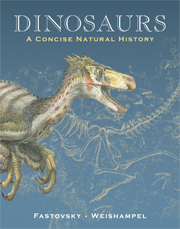Book contents
- Frontmatter
- Contents
- Why a natural history of dinosaurs?
- Dedication
- Part I Reaching back in time
- Part II Ornithischia: armored, horned, and duck-billed dinosaurs
- 5 Thyreophorans: the armor-bearers
- 6 Marginocephalia: bumps, bosses, and beaks
- 7 Ornithopoda: the tuskers, antelopes, and “mighty ducks” of the Mesozoic
- Part III Saurischia: meat, might, and magnitude
- Part IV Endothermy, endemism, and extinction
- Glossary
- Figure credits
- Index of subjects
- Index of genera
5 - Thyreophorans: the armor-bearers
- Frontmatter
- Contents
- Why a natural history of dinosaurs?
- Dedication
- Part I Reaching back in time
- Part II Ornithischia: armored, horned, and duck-billed dinosaurs
- 5 Thyreophorans: the armor-bearers
- 6 Marginocephalia: bumps, bosses, and beaks
- 7 Ornithopoda: the tuskers, antelopes, and “mighty ducks” of the Mesozoic
- Part III Saurischia: meat, might, and magnitude
- Part IV Endothermy, endemism, and extinction
- Glossary
- Figure credits
- Index of subjects
- Index of genera
Summary
Chapter objectives
Introduce Thyreophora, particularly its two large constituent groups, Stegosauria and Ankylosauria
Develop familiarity with current thinking about the lifestyles and behaviors of thyreophorans
Develop an understanding of thyreophoran evolution using cladograms, and an understanding of the place of Thyreophora within Dinosauria
Thyreophora
In life as in games, offense and defense are strategies, each with its own advantages and disadvantages. Thyreophora (thyreo – shield; phora – bearing or carrying; literally, “armor bearers”) went with defense, evolutionarily opting for fortress-like protection and armor. And the strategy paid off: these dinosaurs did very well during their approximately 100 million years on Earth, spawning upward of 50 species.
Who are thyreophorans?
All thyreophorans are characterized by parallel rows of special bones, embedded in the skin, called osteoderms (osteo – bone; derm – skin), that run down the necks, backs, and tails. The group is dominated by two great clades: Stegosauria (stego – roof); and Ankylosauria (ankylo – fused). Together, stegosaurs and ankylosaurs make up a monophyletic clade known as Eurypoda (eury – broad; poda – feet). Along with these two big groups, a few other miscellaneous, primitive Early Jurassic thyreophorans round out our story. Figure 5.1 lays out basic thyreophoran relationships.
Primitive Thyreophora
Primitive thyreophorans, outside of Ankylosauria and Eurypoda, are represented by three forms: Scutellosaurus, Emausaurus, and Scelidosaurus (Figure 5.2). Although primitive ornithischians in most respects, all have the diagnostic thyreophoran character of rows of osteoderms down the back and tail.
- Type
- Chapter
- Information
- DinosaursA Concise Natural History, pp. 84 - 107Publisher: Cambridge University PressPrint publication year: 2009

